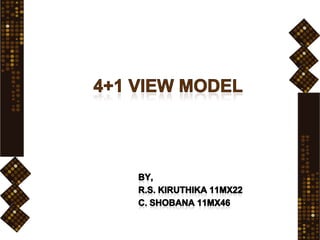
4+1 view model
- 2. 4+1 View Model Designed by : Philippe Kruchten Designed for : Describing the architecture of software-intensive systems, based on the use of multiple, concurrent views
- 3. What is View Model ? A view model in systems engineering or software engineering is a framework. It defines a coherent set of views to be used in the construction of a system architecture or software architecture. A view is a representation of a whole system from the perspective of a related set of concerns. Viewpoint modeling has become an effective approach for dealing with the inherent complexity of large distributed systems.
- 4. Intent of 4+1 view model To come up with a mechanism to separate the different aspects of a software system into different views of the system. But why???? -> Different stakeholders always have different interest in a software system. DEVELOPERS – Aspects of Systems like classes SYSTEM ADMINISTRATOR – Deployment, hardware and network configuration. Similar points can be made for Testers, Project Managers and Customers.
- 5. Solution came from 4+1 View Model The views are used to describe the system from the viewpoint of different stakeholders, such as end-users, developers and project managers. The four views of the model are: -> Logical View -> Development View -> Process View -> Physical View In addition selected use cases or scenarios are utilized to illustrate the architecture serving as the 'plus one' view.
- 7. The 4+1 View model End user Development Programmers Logical view & software view managers Scenarios Process View Physical View Integrator System Engineer Describes software architecture using five concurrent views.
- 8. Logical View (Object-oriented Decomposition) Viewer : End-user Considers : Functional requirements- What the system should provide in terms of services to its users. This view shows the components (objects) of the system as well as their interactions / relationships. UML diagrams – Class, State, Object, Sequence, Communication diagrams.
- 9. Process View (The process decomposition) Viewer : Integrators Considers : Non - functional requirements (concurrency, performance, scalability) The process view shows the processes / workflow rules of a system and how those processes communicate with each other. UML diagrams – Activity diagram
- 10. Development View (Subsystem decomposition) Viewer : Programmers and Software Managers Considers : software module organization (Hierarchy of layers, software management, reuse, constraints of tools) It gives a building block view of the system. Eg: Packages Used, Execution Environments, Class Libraries and Sub systems utilized. UML diagrams – Component, Package diagrams.
- 11. Physical Views (Mapping the software to the Hardware) Viewer : System Engineers Considers : Non-functional req. regarding to underlying hardware (Topology, Communication) This view shows the systems execution environment UML diagram – Deployment diagram.
- 12. Scenario / Use case View (Putting it all together) Viewer : All users of other views and Evaluators. Considers : System consistency, validity Validation and illustration to show the design is complete It is redundant with other views. UML diagram – Use case diagrams.
- 13. Relationship among the views Concurrency is not addressed in the logical view, to achieve the process view, we need to map classes and their objects onto tasks and processes addressing concurrency and synchronization. The processes and process groups are mapped onto the processing nodes of a physical computer network to obtain the physical view. For each dependency between components, there must be a corresponding link between nodes. The logical view is also the basis for the development view. Normally each class corresponds to a module. Large classes may be decomposed into packages. Collections of classes are grouped into subsystems.
- 14. Modeling a system Decide which views are needed to best express the architecture of the system and to expose the technical risks to the project. For each of these views, decide the artifacts(eg. UML Diagrams) needed to be created to capture the essential details of that view. As part of process planning, decide which of the UML diagrams require frequent reviews and which have to be documented. Allow room for diagrams that are thrown away. Such transitory diagrams are useful for exploring the implications of decisions taken and for experimenting with changes.
- 15. Views – UML Diagrams A simple Monolithic Application that runs on a single machine requires… • Use case view Use case Diagrams • Design view Class Diagrams Interaction Diagrams • Process view None • Implementation view None • Deployment view None
- 16. Views – UML Diagrams A complex, distributed system requires… • Use case view Use case Diagrams Activity Diagrams • Design view Class Diagrams Interaction Diagrams State chart Diagrams • Process view Class Diagrams Interaction Diagrams • Implementation view Component Diagrams • Deployment view Deployment Diagrams
- 17. Why is it called the 4 + 1 instead of just 5? The use case view has a special significance. When all other views are finished, it's effectively redundant. However, all other views would not be possible without it. It details the high levels requirements of the system. The other views detail how those requirements are realized.
- 18. 4+1 View model came before UML It's important to remember the 4 + 1 approach was put forward two years before the first introduction of UML which did not manifest in its first appearance until 1997. UML is how most enterprise architectures are modeled and the 4 + 1 approach still plays a relevance to UML today. UML 2.0 has 13 different types of diagrams - each diagram type can be categorized into one of the 4 + 1 views. UML is 4 + 1 friendly!
- 19. Is it important? It makes modeling easier. Better organization with better separation of concern. The 4 + 1 approach provides a way for architects to be able to prioritize modeling concerns. The 4 + 1 approach makes it possible for stakeholders to get the parts of the model that are relevant to them.
